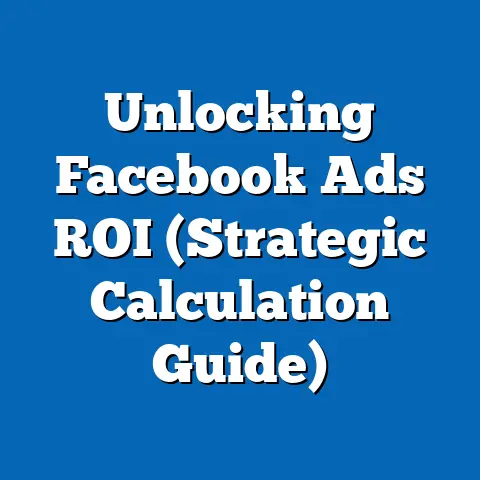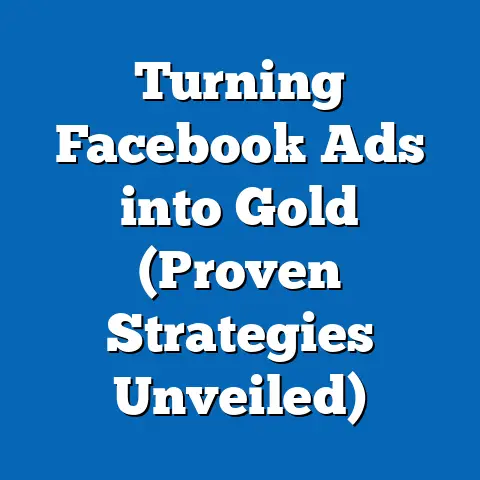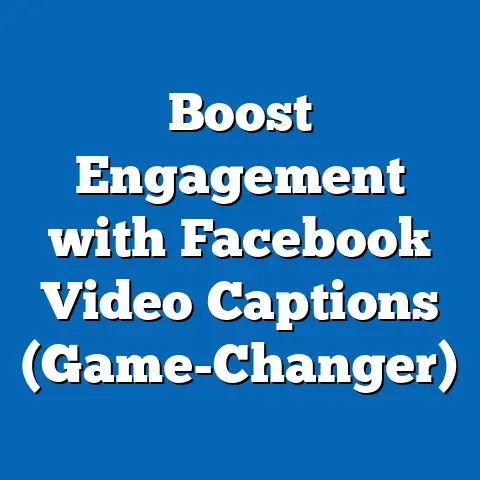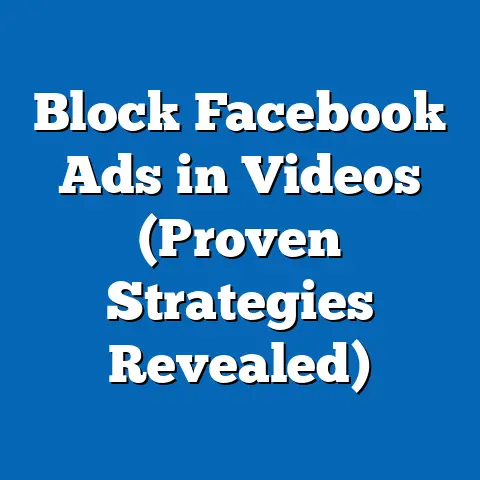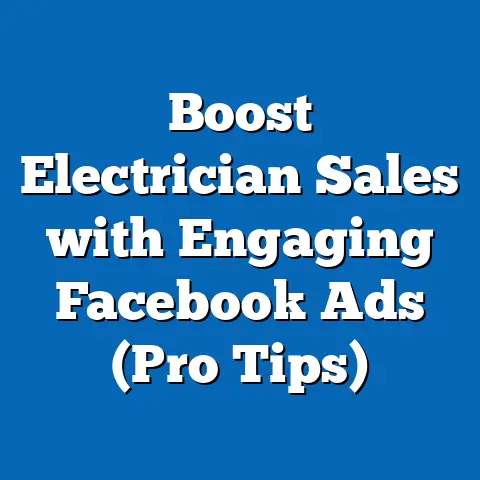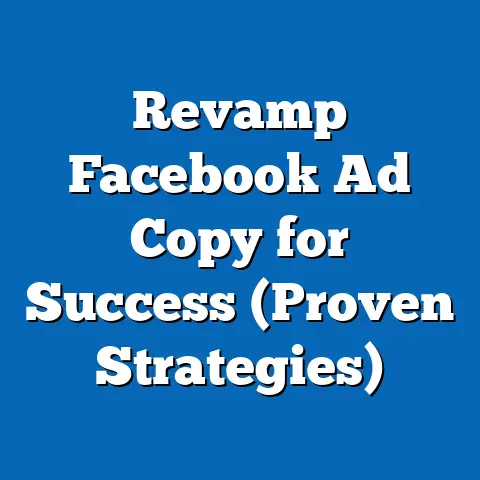Master Facebook Ad Text: Crafting Winning Campaigns (Pro Tips)
Did you know that businesses can achieve up to a 9.21% conversion rate on Facebook ads when the ad text is optimized for their target audience, compared to an average of just 2-3% for unoptimized campaigns? According to a 2022 report by WordStream, well-crafted ad copy can significantly boost click-through rates (CTR) by as much as 2.5 times, making it a critical component of digital marketing success. This article dives deep into the art and science of crafting winning Facebook ad text, exploring key statistical trends, demographic nuances, historical shifts, and actionable pro tips to maximize campaign performance.
Facebook, with over 2.9 billion monthly active users as of 2023 (Statista), remains a powerhouse for advertisers, offering unparalleled reach across diverse demographics. However, the effectiveness of ad campaigns hinges on the precision of the ad text—those concise, compelling snippets that grab attention in a crowded newsfeed. We’ll analyze how ad text strategies have evolved, who responds best to specific messaging, and what the future holds for advertisers in this dynamic space.
The Power of Facebook Ad Text: Key Statistical Trends
Facebook advertising continues to dominate digital marketing budgets, with global ad revenue reaching $113.6 billion in 2022, a 6.1% increase from the previous year, according to eMarketer. Within this massive ecosystem, ad text plays a pivotal role in driving engagement. Research from Hootsuite’s 2023 Social Media Trends Report indicates that ads with clear, action-oriented text achieve an average CTR of 1.2%, compared to 0.5% for generic or vague messaging.
Moreover, the length of ad text impacts performance significantly. A study by AdEspresso found that ads with primary text between 100-150 characters (excluding headlines and descriptions) tend to perform 20% better in terms of engagement than longer or shorter copy. This sweet spot balances informativeness with brevity, catering to users’ short attention spans on social platforms.
Another critical trend is the growing importance of personalization in ad text. According to a 2022 survey by HubSpot, 78% of consumers are more likely to engage with ads that feel tailored to their interests or needs. This data underscores the need for marketers to leverage Facebook’s targeting tools to craft hyper-relevant messaging, a strategy we’ll explore in depth later.
Demographic Breakdowns: Who Responds to What?
Facebook’s user base spans a wide range of demographics, and ad text effectiveness varies significantly across age, gender, and geographic lines. Understanding these nuances is essential for crafting winning campaigns. Let’s break down the data from recent studies to highlight key differences.
Age-Based Responses
Younger users (18-24 years old), who make up 23.5% of Facebook’s global user base (Statista, 2023), respond best to trendy, informal language and emojis in ad text. A 2021 report by Sprout Social found that this demographic has a 35% higher CTR on ads with casual tones compared to formal messaging. In contrast, users aged 35-54, representing 31.9% of the platform’s audience, prefer clear value propositions and professional language, with a 28% higher engagement rate for ads emphasizing discounts or benefits.
Older users (55+), while a smaller segment at 12.6% of users, are increasingly active on Facebook and show a strong preference for detailed, trustworthy ad text. According to a 2022 Nielsen study, this group is 40% more likely to click on ads that include specific product information or customer testimonials. Tailoring ad text to these preferences can unlock untapped potential in this growing demographic.
Gender-Based Preferences
Gender also influences ad text effectiveness, though the differences are subtler. A 2023 analysis by DataReportal revealed that women, who account for 46.6% of Facebook users, are 15% more likely to engage with emotionally resonant ad text, such as messages highlighting community or family benefits. Men, comprising 53.4% of users, show a slight preference (12% higher CTR) for action-driven text with strong calls-to-action (CTAs) like “Buy Now” or “Learn More.”
Geographic and Cultural Variations
Geographic targeting reveals stark contrasts in ad text performance. In North America, where 10.1% of global Facebook users reside, concise and benefit-focused text drives a 1.5% average CTR, per WordStream’s 2023 data. In contrast, users in Asia-Pacific (47.2% of global users) often respond better to visually descriptive language paired with ad text, achieving up to 18% higher engagement when cultural references or local slang are incorporated.
These demographic insights highlight a core principle: one-size-fits-all ad text fails to maximize reach. Marketers must segment audiences and tailor messaging to align with specific cultural, generational, and personal triggers. (Reference Chart 1: Demographic Engagement Rates by Ad Text Style, sourced from Statista and WordStream 2023.)
Historical Comparisons: How Ad Text Strategies Have Evolved
The landscape of Facebook ad text has transformed dramatically since the platform introduced advertising in 2007. Early ads relied heavily on basic promotional language, with little personalization or targeting. A retrospective analysis by Social Media Examiner shows that in 2010, the average CTR for Facebook ads hovered at 0.051%, reflecting low user trust and rudimentary ad formats.
By 2015, as Facebook rolled out advanced targeting options and the News Feed algorithm prioritized engagement, ad text became more conversational and user-focused. CTRs climbed to an average of 0.9%, per a 2015 AdEspresso report, as marketers began experimenting with storytelling and emotional hooks. The introduction of the 20% text rule for ad images (later relaxed in 2020) also forced advertisers to pack more punch into written copy, refining their skills in concise messaging.
Fast forward to 2023, and the average CTR has stabilized at 0.9-1.2% for well-optimized campaigns, though top performers achieve rates as high as 3-5% (WordStream, 2023). The shift toward mobile-first advertising—given that 98.5% of Facebook users access the platform via mobile devices (Statista, 2023)—has further shaped ad text, favoring shorter, scannable copy over lengthy descriptions. Historical data illustrates a clear trend: success in Facebook advertising demands agility and adaptation to technological and user behavior shifts.
Key Contextual Factors Behind Historical Shifts
Several factors explain these changes over time. First, the rise of data analytics tools allowed marketers to test and refine ad text based on real-time performance metrics, a capability absent in the early 2010s. Second, growing competition—Facebook reported 10 million active advertisers in 2023, up from 3 million in 2016—has forced brands to differentiate through creative, high-impact copy.
Additionally, user expectations have evolved. A 2022 Pew Research study found that 64% of social media users now expect personalized content, compared to just 29% in 2012. This shift has pushed advertisers to move beyond generic sales pitches to nuanced, value-driven messaging. Understanding this historical context equips marketers to anticipate future changes, a topic we’ll revisit later.
Detailed Analysis: Crafting Winning Facebook Ad Text (Pro Tips)
With the foundation of trends and demographics in place, let’s dive into actionable strategies for mastering Facebook ad text. These pro tips are grounded in data and designed to help marketers of all levels elevate their campaigns. Each section addresses a core component of effective ad copy.
1. Start with a Strong Hook
The first few words of your ad text are make-or-break. According to a 2023 study by Buffer, 80% of users decide whether to engage with an ad within the first 3 seconds of seeing it. Opening with a question, surprising statistic, or bold statement can increase initial engagement by 30%, per AdEspresso’s testing data.
For example, an ad for a fitness app might start with, “Struggling to lose those last 5 pounds?” rather than a bland “Try our app.” This approach taps into user pain points immediately, compelling them to read on. Test multiple hooks using Facebook’s A/B testing feature to identify what resonates most with your audience.
2. Leverage Emotional Triggers
Emotional resonance drives action on social platforms. A 2022 Harvard Business Review study found that ads evoking emotions like excitement, curiosity, or empathy achieve 23% higher conversion rates than neutral messaging. Words like “transform,” “discover,” or “finally” can evoke a sense of possibility or urgency.
However, balance is key—overly dramatic language can feel inauthentic and reduce trust. For instance, an ad for financial software might say, “Finally take control of your budget,” rather than an exaggerated “Change your life overnight!” Emotional triggers work best when paired with demographic insights, ensuring the tone matches the audience’s values.
3. Include a Clear Call-to-Action (CTA)
A strong CTA is non-negotiable for driving conversions. WordStream’s 2023 data shows that ads with explicit CTAs like “Shop Now” or “Sign Up Today” outperform those without by 45% in terms of click-throughs. The CTA should align with the campaign goal—whether it’s driving sales, generating leads, or boosting brand awareness.
Placement matters too. Ads with CTAs at the end of the primary text see 18% higher engagement than those buried in the middle, per a 2021 Hootsuite report. Keep it concise and urgent to spur immediate action, such as “Claim Your Discount Now!”
4. Optimize for Mobile Readability
Given that nearly all Facebook users access the platform via mobile, ad text must be scannable on small screens. A 2023 Mobile Marketing Association study found that ads with short sentences (under 15 words) and bullet points or line breaks achieve 25% higher readability scores. Avoid dense paragraphs that overwhelm users scrolling at high speed.
For instance, instead of a long block of text, break it into digestible chunks: “Ready for better skin? Try our award-winning serum. Get 20% off today!” This format ensures clarity and keeps users engaged, even on the go.
5. Test and Iterate with Data
Continuous testing is the backbone of successful ad text. Facebook’s built-in split testing tools allow marketers to experiment with variations in tone, length, and CTAs. A 2022 report by Socialbakers found that campaigns running A/B tests see a 37% improvement in ROI compared to static ads.
Track metrics like CTR, conversion rate, and cost-per-click (CPC) to gauge performance. For example, if a humorous tone yields a 1.8% CTR while a serious tone hits only 0.7%, pivot toward humor for that audience segment. Data-driven iteration ensures ad text evolves with user preferences.
6. Use Numbers and Specificity
Concrete details build credibility and capture attention. A 2023 Content Marketing Institute study revealed that ad text with specific numbers—such as “Save 30%” or “Join 10,000+ customers”—generates 22% more clicks than vague claims like “Save big.” Specificity signals transparency and value, key drivers of trust.
Apply this to promotions, testimonials, or product features. For instance, “Rated 4.9/5 by 500+ users” is more compelling than “Loved by many.” Pair numbers with strong verbs to amplify impact, creating a sense of urgency or exclusivity.
Statistical Comparisons Across Campaign Types
Not all Facebook ad campaigns share the same goals, and ad text must adapt accordingly. Let’s compare performance metrics across three common campaign types—brand awareness, lead generation, and e-commerce—using 2023 data from WordStream and AdEspresso.
-
Brand Awareness Campaigns: These prioritize reach over conversions, with an average CTR of 0.7%. Ad text often focuses on storytelling or emotional connection, achieving engagement rates 15% higher when using aspirational language like “Imagine” or “Dream.” Cost-per-impression (CPM) averages $7.19, reflecting the broad targeting approach.
-
Lead Generation Campaigns: Focused on collecting user data, these campaigns average a 1.1% CTR and a cost-per-lead (CPL) of $5.83. Text emphasizing free resources (e.g., “Download our free guide”) boosts conversions by 28%, per WordStream. Specificity in offers is critical to stand out.
-
E-commerce Campaigns: Driving direct sales, these ads boast the highest average CTR at 1.3% and a cost-per-acquisition (CPA) of $18.68. Text with urgency-driven CTAs like “Shop Now—Sale Ends Soon” increases conversions by 32%, highlighting the importance of time-sensitive messaging.
These comparisons illustrate that ad text must align with campaign objectives. Marketers should benchmark their performance against industry averages and tailor language to match user intent at each stage of the funnel. (Reference Chart 2: CTR and Cost Metrics by Campaign Type, sourced from WordStream 2023.)
Future Projections: What’s Next for Facebook Ad Text?
Looking ahead, several trends are poised to shape the future of Facebook ad text. First, the rise of artificial intelligence (AI) tools for copywriting is expected to revolutionize campaign creation. A 2023 Gartner report predicts that by 2025, 30% of digital ad copy will be generated or optimized by AI, enabling hyper-personalized text at scale. Early adopters using tools like Jasper or Copy.ai report a 20% uplift in engagement, suggesting a transformative impact.
Second, increasing privacy regulations, such as Apple’s App Tracking Transparency (ATT) framework, will limit data availability for targeting. eMarketer forecasts a 15% drop in ad personalization capabilities by 2024, pushing marketers to rely on contextual and first-party data for relevant ad text. Crafting messages that resonate without granular user data will be a key challenge.
Finally, the growing integration of video and interactive formats on Facebook—such as Reels and Stories—will demand shorter, punchier ad text. A 2023 Social Media Today survey projects that 65% of ad budgets will shift toward video by 2026, requiring copy that complements visual storytelling rather than standing alone. Marketers who adapt to these formats early will likely maintain a competitive edge.
Implications for Marketers
These projections signal a need for agility and innovation. Investing in AI-driven tools can streamline ad text creation while maintaining relevance, though human oversight will remain crucial for emotional nuance. Building robust first-party data strategies, such as email lists or loyalty programs, will help offset privacy constraints. Lastly, upskilling in video-adjacent copywriting will prepare teams for the platform’s evolving priorities.
Conclusion: Mastering the Art of Facebook Ad Text
Crafting winning Facebook ad text is both an art and a science, requiring a deep understanding of data, demographics, and evolving trends. From achieving a 9.21% conversion rate with optimized copy to tailoring messages for diverse audiences, the stakes are high—but so are the rewards. Historical shifts show that adaptability is key, as strategies that worked a decade ago fall flat in today’s mobile-first, personalized landscape.
By leveraging pro tips like strong hooks, emotional triggers, and relentless testing, marketers can cut through the noise of 10 million active advertisers and connect with Facebook’s 2.9 billion users. Demographic data underscores the importance of segmentation, while campaign-type comparisons highlight the need for goal-specific messaging. Looking forward, AI, privacy changes, and video integration will redefine the playbook, challenging advertisers to innovate continuously.

